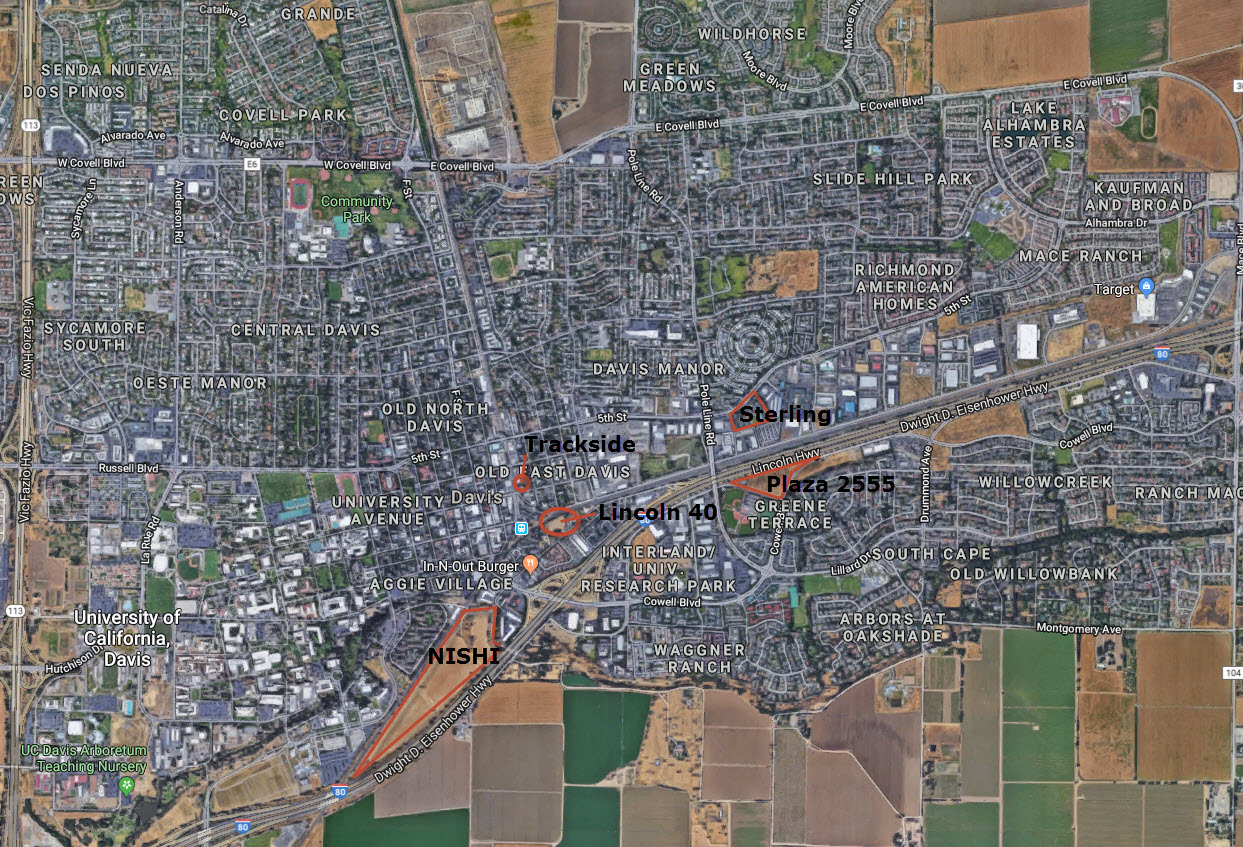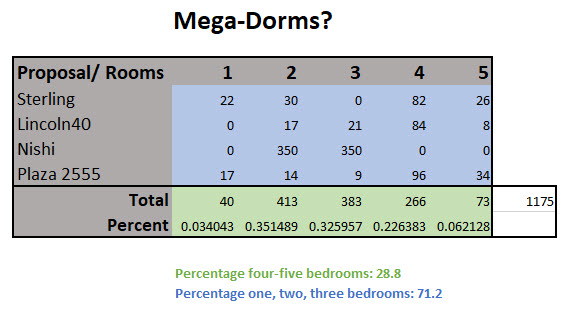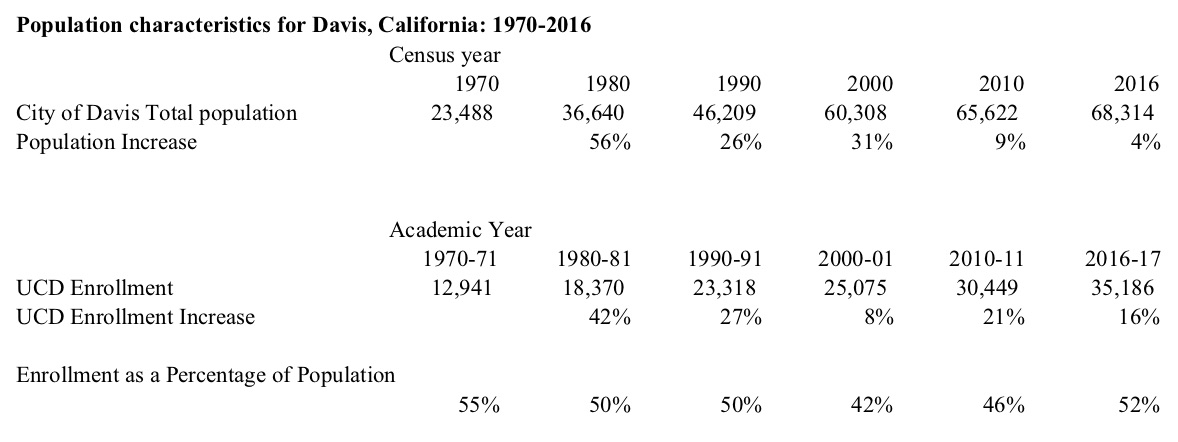
There is an interesting pushback going on as to the recent development proposals in town. At this point it is difficult to know how deep that pushback goes. After all, two years ago at this point, Nishi was already a lightning rod for controversy, whereas to this date, the campaign against Nishi has been fairly quiet.
I saw comments this weekend from people complaining about those who want to pave over the city and surrounding farmland with development.
And yet, as someone else pointed out to me, based on some of the rhetoric out there, you would think that the council had approved a ton of peripheral development or big box retail.
The reality is, even by recent Davis standards, what has been both proposed and approved has been very modest infill. People are screaming as if they had approved a bunch of huge projects. But  by any standard the council has not.
by any standard the council has not.
There is a danger, however, because the rhetoric we are seeing makes it sound like we are sprawling out all over the place. We read about mega-dorms and huge apartment proposals. We heard about the disregard for design guidelines and zoning on Trackside, a four-story mixed-use development that combined retail space with 27 apartments.
While I was not in favor of the Trackside proposal (the biggest problem was it didn’t provide housing for critical needs and it disrupted the neighborhood without providing enough upside), the rhetoric that came out of that debate was at times over the top – as we pointed out at the time.
Still, perspective seems to be in order.

We posted this graphic in our article last week and it applies as much today. We are talking about if we add Trackside to that list, we add five apartment complexes in this community. Five.
Add in the 27 units at Trackside, and you end up with just over 1200 proposed units at those five sites. The vast majority of them are at Nishi, which was approved by council but still requires a Measure R vote.
We are mainly talking about infill sites. The one exception is Nishi. Nishi proposes 700 units, so 700 of the 1202 units are at Nishi. Nishi will be located right next to campus, walking distance from the downtown, and will not have vehicle access onto Richards Boulevard.
The other four proposals have a combined total of 502 units, three of which will be not only infill but redevelopment. Trackside proposes to demolish the underutilized space north of 3rd Street and east of the train tracks (which even the neighbors agree is under-utilized) and will build a larger and more dense building.
Lincoln40 will take older cottages, somewhat in poor shape, and turn the location into an apartment complex within walking and biking distance from campus. Council has yet to approve Lincoln40 at this point.
Council has approved (and the developers have completed) the demolition of the existing facility east of the post office where Sterling will now go in its place.
The only one of the infill projects that seeks out vacant land is Plaza 2555, which is scheduled to go before the council in May. Plaza 2555 takes on the triangular space along Research Park Drive and Cowell Boulevard, nestled up against I-80, and builds units ranging from micro-unit studio flats to townhouses to four- and five-bedroom student-oriented apartments.
If you look at the map, four of the five proposals barely even show up on the map. Nishi is by far the largest proposal at 45 acres. Nothing else even makes a dent on the map.
Perspective.

In 1970, the census listed the size of Davis at 23,488. By 1990, 20 years later, the population had almost doubled. By 2000, 30 years later, it had nearly tripled to 60,000. But in the last 18 years, only about 8000 people have been added to the city – less than 15 percent growth over that time.
Think about the major developments added in recent history, whether it be the sprawling Wildhorse or Mace Ranch. Think about the proposal in 2005 of Covell Village and the 2000 single-family homes it proposed to add to this community. Even the smaller Cannery, 100 acres, was more than twice the size of Nishi.
The rhetoric of mega-dorms, the people accusing the Vanguard and others of wanting to pave over farmland, are way out there rhetorically and such rhetoric does not comport with the reality that we are facing.
Five apartment complexes. That is we what we have in consideration.
We can have a community discussion on the best approach to take to solve the student housing crisis, but I think we should not lose track that the solution put forward thus far has been fairly modest. Density does have impacts on near neighbors, and certainly those living near Trackside feel that their neighborhood will be impacted by that development.
However, in the scheme of things, given the massive and sprawling subdivisions we saw in the 1980s and 1990s, the idea that we can attempt to address a large housing problem, like the student housing crisis, through such modest measures should not be lost upon people.
For the most part the community is behind Measure R. Most people living in this community do not want to see large numbers of peripheral housing in Davis. The massive vote down of Covell Village in 2005 attests to that, as does the even larger vote down of the more modest peripheral development of Wildhorse Ranch in 2009.
Where the community is more divided is on projects like Nishi. In 2016, Nishi was student housing but also for-sale housing with a commercial component, with vehicle access to Richards Blvd. through Olive Drive. For the first time, a Measure R vote was competitive, but it still lost by about 700 votes.
It remains to be seen if voters will approve the 2200-bed project that has no access on Richards Blvd.
But that is what we are down to in terms of peripheral proposals. It seems highly unlikely that we will see a return to the days of Wildhorse or Covell Village – at least not any time soon.
The question for the voters is whether the city has a responsibility to do something to alleviate the student housing crisis. That is probably where the line of demarcation is at this point.
For me, the more I look at the cost of housing on campus, the more I think it is reasonable for the city to add 5000 to 6000 beds in town as long as the university stays true to their commitment to 8500 beds on campus.
I think that is both a pragmatic and moderate approach. I remain a strong supporter of Measure R and I believe that this community remains committed to slow growth and the preservation of agricultural land. However, within those limitations, we have to get creative and sometimes even aggressive as we try to do our best to address community needs.
In all of this, we need to keep perspective. No one is proposing blowing out the borders. No one is proposing sprawling subdivisions on prime ag land. People are simply looking at the best way to utilize finite resources to solve real problems in town.
—David M. Greenwald reporting







Do people look for the best way to utilize finite resources to solve real problems in Davis?
People Do.
https://i.ytimg.com/vi/2eoI5nIWbzo/maxresdefault.jpg
I assume you mean that with the same irony that I take it (took it) for the Chevron commercials.
May . . . . . . be
“While I was not in favor of the Trackside proposal (the biggest problem was it didn’t provide housing for critical needs and it disrupted the neighborhood without providing enough upside”
“People are simply looking at the best way to utilize finite resources to solve real problems in town.”
Some people certainly are. Others are only looking at the best way for them to make money on projects that do not solve any real problems, but only provide luxury accommodations for those who are in need of no assistance whatsoever.
Tia: I think it is important not to put those two quotes together and imply that they are somewhat related.
The context for the second quote: “In all of this, we need to keep perspective. No one is proposing blowing out the borders. No one is proposing sprawling subdivisions on prime ag land. People are simply looking at the best way to utilize finite resources to solve real problems in town.”
David
What I would say is that it is a matter of perspective whether or not those quotes are related. I certainly saw them that way but do not expect agreement. I believe that all of our housing issues whether for students, the homeless, others of fixed or limited income, the affluent, whether renters or homeowners are all interrelated. As are the desires of developers/investors hoping to make a return on investment. What I object to strenuously is pitting one group against another deliberately when a collaborative/innovative approach might yield better results.
And yes, I admit that I have a unique perspective on this.
The REAL PROBLEM is under-supply of housing. Hence those seeking profit by developing housing are solving the real problem.
This is a disingenuous rhetorical class-wedge device. I assume by the assessment of many that you yourself are protecting both your profit (property values) what would be deemed your luxury accommodations with your opposition to certain development.
It is everyone’s right to pursue profit and wealth legally, and the definition of “luxury” is subjective and also a right to pursue. So why would you demonize others for pursuing what you also pursue?
And with respect to this canard about finite resources… the resource constraints are artificially manufactured because otherwise they would not exist.
Artificial? agreed, but they do exist, so not a canard.
Accepted… mine was a canard in a coal mind.
“The REAL PROBLEM is under-supply of housing. Hence those seeking profit by developing housing are solving the real problem.”
I agree.
Jeff
Baloney. Just as building a Neiman Marcus near campus would probably not be as appealing or affordable to much of the campus population as is the Forever 21, neither is all housing created equal. Again, I have no objection to people staying within zoning and design guidelines and building and charging what they see fit. It is when the come “hat in hand” to the City Council asking for favors in the form of exceptions as did both The Cannery and Trackside that I have a problem. I do not see developers as evil. They have a right to make a profit. I do not believe that they have the right to do that at the expense of others without providing a definite benefit to the community by addressing identified needs, including the local neighborhood.
If Tia does not want high end clothing or high end apartments in town I’m wondering if she had any problem with the local car dealers not only selling $50K+ new Japanese cars but also selling $50K used German “Luxury” cars (serious question) ?
https://www.hanleesdavistoyota.com/new/BMW/2016-BMW-X5-483ac6000a0d04fe5bfcbbb548293e62.htm
“Others are only looking at the best way for them to make money on projects that do not solve any real problems, but only provide luxury accommodations for those who are in need of no assistance whatsoever.”
After reading Jeff comment, he flagged something that is bothering me here. The Trackside project may provide luxury accommodations, but people are paying for them, they are not being given assistance. I don’t see that as a strong need in this community, but I do take some issue with your comment.
In a way, the mitigation measures which are part of Nishi 2.0 show that I-80 is also a type of boundary that needs to be enforced – they include an eventually-dense 100 ft. layer of trees and shrubbery followed by a 200 ft. buffer in front of the residential buildings. (My guess is that the 300 ft. distance is based on the California Air Resources Board recommendation of a 500 ft. buffer in front of busy highways BUT that “urban forests” can help with this.)
you’ll see that approximately 2/3 of the proposed Plaza 2555 project area is within that 300 ft. total buffer. And – if that’s not enough – it seems that more people will live here longer than others at Nishi, as it does not have quite the same student-focus (short-term, supposedly less health risks) as Nishi.
So I don’t understand any justification for Plaza 2555 being suitable for residential housing.
There are plenty of other developments just as close to I-80, including apartment complexes to the north, New Harmony, and single-family homes along Chiles and La Vida. Plaza 2555 is a classic infill project which will benefit from vegetative barriers as well as the steadily declining emissions projected for California’s vehicles.
Also it’s down the street from New Harmony and even Thomas Cahill felt that New Harmony wasn’t a problem.